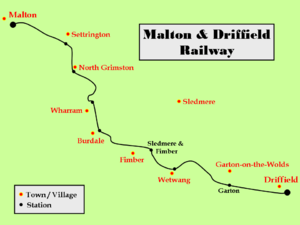Malton and Driffield Railway

The approximate route of the Malton and Driffield Junction Railway. The stations were often a considerable distance from the villages they served.
|
|
| Dates of operation | 1853–Passenger: 3 June 1950 Freight: 20 October 1958 |
|---|---|
| Track gauge | 4 ft 8 1⁄2 in (1,435 mm) standard gauge |
| Length | 20 mi (32 km) |
The Malton and Driffield Junction Railway, later known as the Malton and Driffield branch was a railway line in Yorkshire that ran between the towns of Malton, North Yorkshire and Driffield in the East Riding of Yorkshire.
The line opened on 13 April 1853. It became part of the North Eastern Railway (1854), then London and North Eastern Railway (1923), becoming part of British Railways in 1948. Passenger services on the line gained the nickname the Malton Dodger.
Between the 1920s and 1950s the line saw use transporting chalk from the Burdale and Wharram quarries. Passenger services ended in 1950; the Burdale quarry closed in 1955, and the line closed in 1958.
Promotion of a line between Malton and Driffield dates to at least the mid 1840s when George Hudson subscribed £40,000 towards a Malton and Driffield Junction Company, which was intended to link to a proposed branch of the Great North of England Railway from Thirsk to Malton. The Malton and Driffield Junction Railway was promoted as part of a line of communication from Hull to Newcastle-upon-Tyne and beyond to Scotland as well as opening up the agricultural districts of the East Riding of Yorkshire, and providing a short route to the new seaside resorts on the East Yorkshire coast. A connection via the proposed Thirsk and Malton Railway was required for the connections northward. Both the Newcastle and Darlington Junction Railway (N&DJR) and York and North Midland Railways (Y&NMR) supported the scheme.
A previous scheme from Thirsk to Driffield, the Hull, Malton and Northern Union Railway was resurrected and promoted in opposition, but was unsuccessful. An act empowering the construction of a 24 miles (39 km) line was enacted in June 1846, allowing £240,000 to be raised for its development through shares, and a further £80,0000 through loans.
...
Wikipedia
